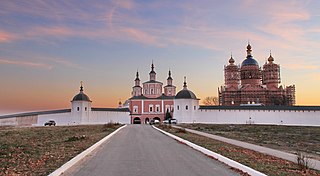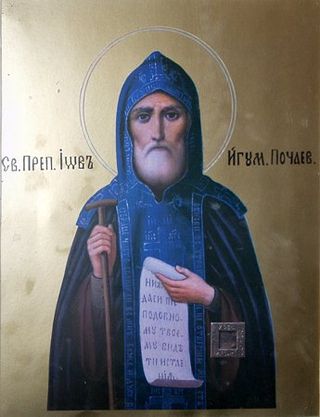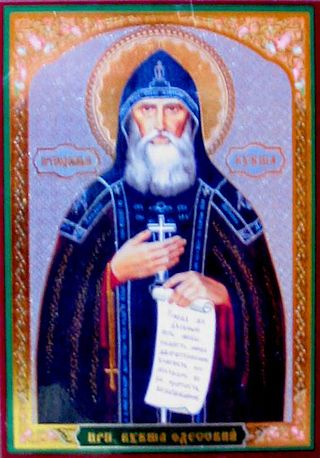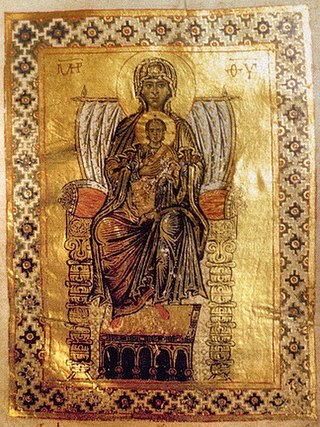
Kyiv-Pechersk Lavra or Kyievo-Pecherska Lavra, also known as the Kyiv Monastery of the Caves, is a historic Eastern Orthodox Christian monastery which gave its name to one of the city districts where it is located in Kyiv.

Nestor the Chronicler or Nestor the Hagiographer was a monk from the Kievan Rus who is known to have written two saints' lives: the Life of the Venerable Theodosius of the Kiev Caves and the Account about the Life and Martyrdom of the Blessed Passion Bearers Boris and Gleb.

September 27 - Eastern Orthodox liturgical calendar - September 29

May 9 - Eastern Orthodox Church calendar - May 11

May 11 - Eastern Orthodox Church calendar - May 13

May 13 - Eastern Orthodox Church calendar - May 15

May 26 - Eastern Orthodox Church calendar - May 28

Anthony of Kiev, also called Anthony of the Caves, was a monk and the founder of the monastic tradition in Kievan Rus'. Together with Theodosius of Kiev, he co-founded the Kiev Pechersk Lavra.

August 14 - Eastern Orthodox liturgical calendar - August 16

August 16 - Eastern Orthodox liturgical calendar - August 18

Theodosius of Kiev or Theodosius of the Caves is an 11th-century saint who brought Cenobitic Monasticism to Kievan Rus' and, together with Anthony of Kiev, founded the Kiev Caves Lavra. A hagiography of Theodosius was written in the twelfth century.

Svensky Monastery is a Russian Orthodox monastery located at the confluence of the Desna and Sven Rivers, three miles from Bryansk, Russia. The monastery was originally known as Svinsky, after the Svin River, but the spelling was subsequently changed to Svensky, because "svinsky" also means "of the swine" in Russian.

Job of Pochayev, to the world Ivan Zalizo, in Great Schema John was an Eastern Orthodox monk and saint.

Kuksha of the Kiev Caves was a monk and martyr from the Kiev Pechersk Lavra. He was canonized as a saint by the Russian Orthodox Church for his work in spreading Christianity among the Vyatichi in present-day Kaluga, Ryazan, and Tula oblasts of Russia.

Kuksha of Odessa, born Kuzma Kirillovich Velichko, was an imperial Russian priest and a Ukrainian Orthodox Church saint who was canonized in 1995.

Agapetus of the Kyiv Caves, or Agapetus of Pechersk, was an Orthodox Christian saint and doctor, as well as a monk in Kyiv Pechersk Lavra. He was born in Kyiv and was taught and admitted to monastic vows by Saint Anthony of Kiev. Agapetus famously provided free medical services for poor people. He also healed grand prince Vladimir II Monomakh.

Panachranta is a type of icon in the Eastern Orthodox Church, that refers to the all immaculate Virgin Mary, the Theotokos.

December 25 – Eastern Orthodox liturgical calendar – December 27

Juliana Olshanskaya was a member of the Olshanski noble family who became a saint in the Eastern Orthodox Church. Dying a virgin around 16 years of age, she was buried in the monastery of Kyiv Pechersk Lavra. Decades later, her body was uncovered during the digging of a new grave. It is claimed that her remains were in a state of incorruptibility; relics were taken and she was venerated as a saint. The early 17th-century Archimandrite Peter Mogila claimed to have had a vision of Saint Juliana in which she reproached him for a lack of respect given to her relics. He arranged for nuns to create a new reliquary. The relics survived a fire in 1718 and are now in the church of the Near Caves. Her feast day is 28 September.












